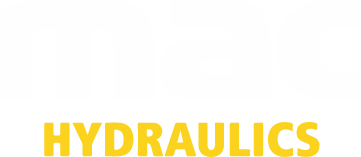Minimizing Hydraulic Cylinder Bent Rods from Side Loads
Minimizing Hydraulic Cylinder Bent Rods from Side Loads
Hydraulic cylinder bent rods caused by side loads can be a big problem when equipment starts to fail. Side loads occur when unequal pressure isn’t centered on the piston rod. They are the most common cause of failure of hydraulic cylinders that would typically last for years. The strain they cause can lead to many problems, including bent tubes, seal failure, piston rod wear, and in extreme cases bending of the rod. Side loads can also damage the rod bearings, put excessive wear on the push rod washer as well as on one side of the cylinder bore.
As these problems worsen, they lead to inefficient operation and eventual failure of the hydraulic cylinders. Luckily, there are ways to prevent hydraulic cylinder bent rods caused by side loading.
Hydraulic Cylinder Mounting
There are different approaches to cylinder mounting that can aid in minimizing misalignment and resulting side loads. Three types of cylinder mounts are common:
Line of force along the centerline of the cylinder;
Line of force along the centerline with the cylinder allowed to articulate along a curved path; and
Line of force along the centerline with an offset mount.
The first type ideally prevents side loads, but may not be as successful in practice as it is in on paper. Trunnion-mounted or clevis-mounted cylinders, which fall into the second category, both have the capability of moving with the side load and can help minimize side loads. The third style is not good for applications where side loads could be a problem. As a side note, head-style mounts provide superior column strength to cap-end mounts because the mounting points are closer together. Better column strength means less buckling and a reduced probability for side loads.
Stop Tubes and Dual Pistons
One of the most useful approaches to minimizing side loads is the use of a stop tube, which is a tube that lies around the rod between the piston and the head inside the cylinder. A stop tube adds to buckling resistance and increases the distance between the piston and the rod bushing to minimize the effects of buckling. A stop tube provides support to the rod during extension when it is most susceptible to side loads and also prevents problems with jack-knifing. However, the use of a stop tube may necessitate a longer stroke length because a stop tube will limit stroke length.
Dual pistons are similar to stop tubes with one exception: they provide more bearing surface to support side loads. Both stop tubes and dual pistons are popular solutions when problems develop with side loads but should be considered during the design and specification phase for a hydraulic cylinder.
Precise Alignment During Installation
No other method discussed here can take the place of proper, precise alignment during installation. When a hydraulic cylinder is installed, the technician must take care to minimize misalignment in both its retracted position and its fully extended position. Note that alignment should also be periodically checked during maintenance.
Guiding for Rods and Pistons
Guides, including guide rings, provide the support needed to keep the piston rod and piston properly centered under loadings. They are especially useful during horizontal strokes or very long strokes as they minimize inevitable hydraulic cylinder bent rods from side loads. There are a variety of guides available for use with rods and pistons.
Minimizing Hydraulic Cylinder Bent Rods with Rod Size
Another way to minimize the effects of hydraulic cylinder side loads is to consider the use of larger diameter rods. A larger rod will have more strength and experience less bending. Rod sizes should be chosen with attention to buckling, sagging, and bending – when these issues are properly addressed, side loads will be minimized. Selection of the correct rod size goes a long way in preventing failures due to side loads. Drawbacks to keep in mind include added weight and higher costs of the rods.
Misalignment Compensation
One effective method of compensating for inevitable misalignment is the use of a spherical eye rod or spherical bearing mount. The drawbacks for this method are that these types of bearing mounts will typically require a larger diameter piston tube or a longer stop tube. The longer stop tube is needed to compensate for a high level of bearing stresses because there is not going to be as much rigidity between the load and the piston rod.
First Rate Hydraulic Cylinder Repair Facility in Delaware County
Hydraulic cylinder bent rods caused by side loads are one of the primary causes of cylinder failure, which means that careful attention to alignment and minimizing the effects of side loads can save costs in both repairs and downtime. The methods discussed here can help minimize the problems caused by side loads, but sometimes it can be difficult to determine which solution is best for your application.
At MAC Hydraulics, we can help you maintain, align, and repair your cylinders – and help you find the most effective, economical solution to any side load problems you are facing. When your cylinders fail, you can count on our fast and reliable services to get you running again as soon as possible. Our cylinder repair services include replacing seals, honing the tube, polishing the rod, and any custom fabrication that may be needed. MAC Hydraulics’ on-site maintenance services also include hydraulic cylinders, which means your cylinders will be maintained and aligned by expert, skilled technicians who understand not just the technical aspect of your equipment but also how important hydraulic cylinders are to your systems. Contact MAC Hydraulics today to find out what we can do for you.


 Line of force along the centerline of the cylinder;
Line of force along the centerline of the cylinder;



